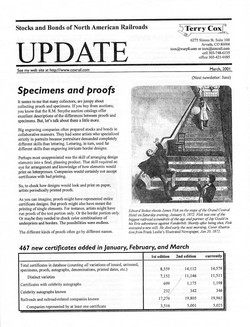
Specimens and Proofs
It seems to me that many collectors, are jumpy about collecting proofs and specimens. If you buy from auctions, you know that the R.M. Smythe auction catalogs offer excellent descriptions of the differences between proofs and specimens. But, let’s talk about them a little more.
Big engraving companies often prepared stocks and bonds in collaborative manners. They had some artists who specialized strictly in portraits because portraiture demanded completely different skills than lettering. Lettering, in turn, used far different skills than engraving intricate border designs.
Perhaps most unappreciated was the skill of arranging design elements into a final, pleasing product. That skill required an eye for arrangement and knowledge of how elements would print on letterpresses. Companies would certainly not accept certificates with bad printing.
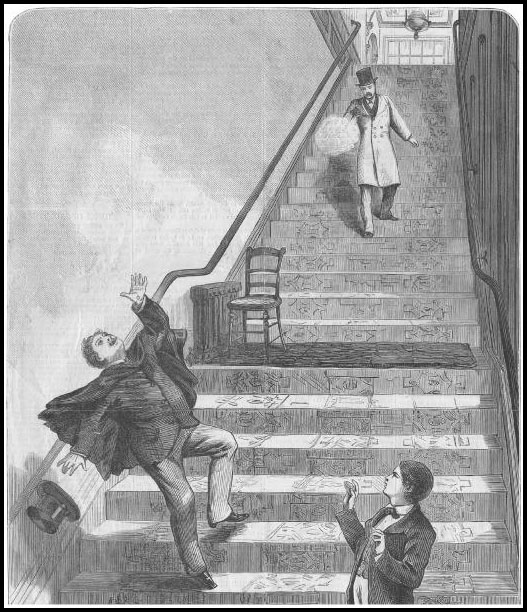 Edward Stokes shoots James Fisk on the steps of the Grand Central Hotel on Saturday evening, January 6, 1872. Fisk was one of the biggest railroad scoundrels of the age and partner of Jay Gould in his Erie adventures against Vanderbilt. Shortly after being shot, Fisk executed a new will. He died early the next morning. Cover illustration from Frank Leslie’s Illustrated Newspaper, Jan 20, 1872.
Edward Stokes shoots James Fisk on the steps of the Grand Central Hotel on Saturday evening, January 6, 1872. Fisk was one of the biggest railroad scoundrels of the age and partner of Jay Gould in his Erie adventures against Vanderbilt. Shortly after being shot, Fisk executed a new will. He died early the next morning. Cover illustration from Frank Leslie’s Illustrated Newspaper, Jan 20, 1872.
So, to check how designs would look and print on paper, artists periodically printed proofs.
As you can imagine, proofs might have represented entire certificate designs. But proofs might also have meant the printing of single elements. For instance, artists might have run proofs of the text portion only. Or the border portion only. Or maybe they needed to check color combinations of underprints and borders. The possibilities were endless.
The different kinds of proofs often go by different names.
“Progress proofs” were meant to check the progress in the engraving of elements, particularly text wording. “Color proofs” were meant to check colors in some manner.
Artists engraved in soft steel. They did not heat-treat and harden their designs until they were absolutely sure their dies were finished. Until hardening, working dies were relatively delicate. Consequently, proofs had to be printed very carefully on soft paper.
Many proofs were printed on India paper which is thin, but durable when dampened for printing. Equally common are proofs printed on thicker, but soft, fibrous, card-like stock. The problem with card stock proofs is that the paper commonly was of poor quality and did not age well. Consequently, card-stock proofs are often found folded, tattered, dog-eared, and torn.
Proofs were never printed with serial numbers. All of the proofs that I know of were printed on one side only. Many were marked with artists’ notes, dates, and plate numbers. It is very common to see proofs marked with all sorts of pencil scribbling and colored ink.
Specimens, on the other hand, represent finished designs. They were (to the best of my knowledge) always printed on two sides. They were printed on the same paper as regular certificates. They were essentially regular, unissued certificates with three major differences. 1) Specimens were normally numbered with “00000” serial numbers. 2) They were normally stamped with “SPECIMEN.” 3) They were normally cancelled with tiny punches in the signature areas
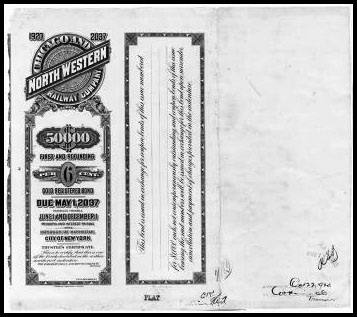 Although quite unimpressive, this torn card-stock proof of the back of a $50,000 registered C&NW bond is the only evidence I have of the variety. The front design is known only from a proof of a $10,000 bond of the same issue. These bonds were probably used between 1920 and 1946.
Although quite unimpressive, this torn card-stock proof of the back of a $50,000 registered C&NW bond is the only evidence I have of the variety. The front design is known only from a proof of a $10,000 bond of the same issue. These bonds were probably used between 1920 and 1946.
Unfortunately, not all specimens were numbered “0”. Not all were stamped “SPECIMEN.” And not all were cancelled.
Normally, printing houses retained a few specimens for their own files and sent a few specimens to railroad companies.
You will find some specimens, especially those created by small and local firms, numbered with high serial numbers. Some railroad companies cancelled regularly-issued examples and retained them as specimens.
In theory, every proof is unique, or nearly so. And except for a few exceptions, specimens exist in very limited numbers.
Unfortunately, not all proofs survive in terrific condition. And some certificates can be represented by ten or twenty specimens.
Nonetheless, half of all proofs and specimens represent the only known certificate evidence of companies. In fact, 16% of all the companies represented by certificates in the database, are represented only by specimens or proofs.
Furthermore, only about a quarter of all proofs and specimens can be matched with regular-issue certificates. That is because companies often destroyed their stocks and bonds upon redemption.
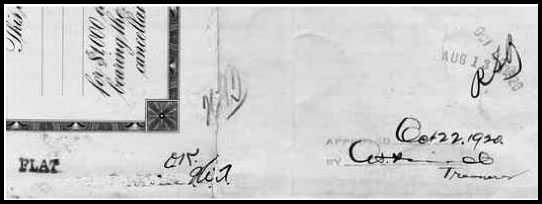 Enlargement of the proof at left showing typical approval marks from four different people.
Enlargement of the proof at left showing typical approval marks from four different people.
Overall, 20% of all known varieties of certificates — one out of every five varieties — are collectible only in the form of proofs or specimens.
The importance of proofs and specimens to the hobby, and their rarity, cannot be overstated. Currently, three-quarters of all proofs and specimens are represented by a SINGLE occurrence in a pricelist, auction, or web appearance. All told, 15% of all known certificate varieties are known only from one appearance of a proof or specimen. That does not mean all those examples are unique. But it means you will have a hard time filling out a collection if you don’t collect proofs and specimens.
467 New Certificates added in January, February, and March
|
1st Edition |
2nd Edition |
Currently |
| Number of certificates listed (counting all variants of issued, specimens, etc.) |
8,559 |
14,112 |
14,579 |
| Number of distinct certificates known |
7,152 |
11,146 |
11,511 |
| Number of certificates with celebrity autographs |
699 |
1,175 |
1,198 |
| Number of celebrity autographs known |
232 |
342 |
346 |
| Number of railroads and railroad-related companies known |
17,276 |
19,805 |
19,1963 |
| Number of companies for which at least one certificate is known |
3,516 |
5,001 |
5,025 |
Scarce Arizona Certificates to be Auctioned
James Garbani, a long-time correspondent, contributor, and Arizona mining author, will auction his extensive collection through Fred Holabird in February, 2002. The bulk of the collection will consist of about 1,200 Arizona and Arizona Territorial mining certificates, broadsides, maps, and prospectuses. Hidden among that hoard will be several scarce and rare Arizona railroads including the Arizona & New Mexico and the Arizona & Prescott Central. Contact Fred Holabird for a catalog. (3555 Airway Dr., Suite 308, Reno, NV 89511; 775-852-8822 or fred@holabird.org.)
So, When is the Second Edition Coming Out?
That has been the recurrent theme the last three months. I don’t know how many e-mails and letters I’ve received asking that question. In fact, I delayed this newsletter, hoping to learn something. Embarrassingly, I cannot shed any light on the answer. Everything is up to the publisher.
In the Meantime...
I am trying to create a searchable database that I can hook to the web site. The goal is to allow you to search the database, to see what certificates are available. Of necessity, I will need to abbreviate the database in some manner. Obviously, I want to enhance book sales, not hurt them.
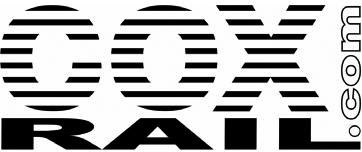
Redesigned Website
In the past month, I completely re-worked my “COXRAIL” web site. While the site looks and feels the same, I tried to simplify navigation. I boosted the size of the “celebrity autograph” section to four huge pages. It now lists every occurrence of every known major autograph on railroad stocks and bonds. I also added all my past newsletters.
Additionally, I have added links to dealers and organizations on every page. From there, you can find addresses and/or web links to every dealer and organization I know of who deals with railroad certificates. Please tell me if you know other dealers to add.
My goal with the web site is to promote the hobby and I want to give collectors a point from which they can discover dealers and collecting organizations.
Can You Help?
Certificates from some companies are genuine mysteries. Often, collectors think of such certificates as overly common. Unfortunately, many varieties are really not common, and solving such mysteries is impossible without new information.
Would you please, please, please help by sending copies of any certificates from these companies?
- Housatonic Railroad (any and all certificates)
- Pennsylvania RR stock allotment receipts
- New York Central RR bonds showing Grand Central Station
- Equipment trust (any equipment trust from any railroad
Yes, any certificates whatsoever! Even if they appeared correctly in the first edition.
Every single copy you send will help. If you have several copies of identical certificates, I beg you to send copies of the earliest and latest dates. (Reduce to 81/2 x 11, black and white.)
Because My Goal is...
To list every certificate from every company.
Yes, I know. That is rather insane and certainly impossible.
But, since you collect certificates and I collect information, how about we help each other?
And Along Those Same Lines...
If you have a certain area of interest, and you want to learn what items I currently have listed, just ask. I will gladly send a printout of all the certificates I currently know about in that area. Please send specific railroad company names as well as those of ancestor and descendent companies.
I have almost 20,000 company names in the database, but I do not collect information about company genealogies. Therefore, assume that I do not know historic company relationships.
One of the areas that has shown the most interest in the last year is the Seaboard Air Line and related southeastern companies. Also Texas. Consequently the level of contributions from those areas has risen dramatically.
However, there are huge holes in my knowledge about many companies. So, even if you are a major dealer, feel free to ask for a partial listing in a particular area of interest. I guarantee you have unlisted items.

Okay, tell me what I’m missing!
Do you collect stock certificates based on the written numbers of shares issued? I am not talking about collecting distinctly different varieties, such as 100-share certificates or <100-share certificates or odd-share certificates.
The reason I am asking is because, in an average month, I see several hundred listings of stock certificates worded like Baltimore & Southwestern Railroad Co. 1882. Brown. 10 shares.
I see so many listings like that I am starting to wonder what I am missing. Why do so many dealers and auction houses list numbers of shares in their descriptions of stock certificates? Is that critical information?
Is this a feature of collecting I have overlooked?
Yes, very high denominations are important to some collectors. Such certificates might have represented controlling interests in some companies.

But not minor share values. So I wonder, do you collect on the basis of shares? Do you collect 1-share certificates or 10-share certificates or something like that? Do you pay premiums for certain issued amounts?
So far, not a single person has ever told me they collect in such a specialized manner.
I want to hear from you. I genuinely want to know how you collect. Do you collect in any specialized manner?
You see, I am heavily focused on the big picture. I may overlook features you want to know about. Maybe that is numbers of shares. Or artists. Or vignettes. Or printing companies. I won’t know unless you tell me.
My goal is to describe subjects you think important. So I really want to hear from you, even if you are a generalist. I want a better picture of the collecting habits of people who, like me, enjoy these arcane pieces of paper.